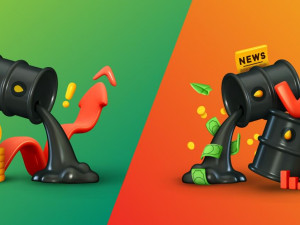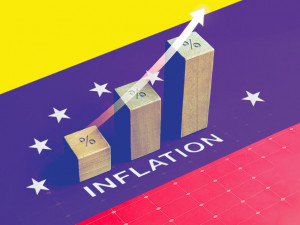
Dollar dominance refers to the general economic power that is held by the US dollar over the world economy. The US dollar is the most used currency, and is at the heart of commodities such as oil and gold, and financial industries such as forex.
The US dollar is also the global reserve currency, positioning the US as the most powerful economy in the world. The US’s foreign policy, the anchoring of dollars in global cash reserves and the general might of the American economy often pushes down other countries and economies, which is what many people label as dollar dominance.
With a GDP of $26.95tn and climbing, the US economy and dollar looks to stay dominant for decades to come, despite some suggestions of dedollarisation. But how did the US dollar become so dominant? And what implications does this have for the world economy?

Beginnings of dollar dominance
The Bretton Woods system is where dollar dominance began to take hold, as 44 of the world’s largest currencies were pegged to the US dollar, and the dollar to gold.
Post 1945, there was a growing concern that if countries became isolationist in their economic policies, it would drag the world further into economic ruin. Implementing policies that tend to worsen the economies of other countries, either unintentionally or intentionally, are known as ‘beggar thy neighbour’ policies.
There was a position to fill for a reserve currency, and the US stepped up. Relatively unaffected by the Second World War, compared to say Britain or France, the US dollar had a stability that could be relied upon. The US dollar was fixed to the price of gold, and then all major currencies that agreed would be fixed to the dollar, causing a global cohesion of currencies that would avoid beggar thy neighbour policies and help the world pull itself out of economic ruin.
The US also controlled two-thirds of the world’s gold reserves at the time, so they could ensure oversight over the gold market. The Bretton Woods system ended abruptly in 1971, but this dependence on the US dollar remained, as many currencies couldn’t become fiat currencies, or give up the benefits of a fixed exchange rate.
Today, the US dollar is the official currency of 11 countries, is the main peg for 65 currencies, and makes up approximately 58% of all global reserves.
Dollar dominance & oil
Much of dollar dominance today comes from the fact that oil is traded in dollars, and has been almost exclusively since the 1970s.
The conversion of Saudi Arabia in 1975 to start trading oil in dollars, and afterwards the rest of OPEC, anchored the dollar in the global oil economy. It meant that countries would need to buy dollars in oil if they wanted it from the Middle East, so they would need to store large amounts of dollars in their reserves. These dollars are known as petrodollars.
These dollars are also often reinvested into US treasury securities, increasing profits but also the dependency on the US economy.
Aspects of dollar dominance
Dollar dominance is not just based on oil and other commodities. In fact, the dominance of the currency has spread into multiple areas of the world economy.
The US dollar is the preferred currency for international trade, and has become a medium of exchange for all the largest economies in the world.
In the forex market, all of the most-traded currency pairs involve the US dollar:
These are referred to as major pairs, and by definition will include the dollar. Major pair trading makes up 75% of all forex trades.
The popularity of these major pairs creates a snowball effect, as due to the volume of trading, they have the tightest bid and ask spreads, therefore are the most predictable and therefore the most attractive to traders. This further increases dependency on the US dollar.
Many international financial instruments such as bonds and derivatives will use the US dollar, and will be issued and traded in USD, regardless of which country they are in.
Transferring money will also make use of US dollars. International bank transfers that involve SWIFT are using US dollars more than any other currency.
Is dollar dominance bad?
For the US, dollar dominance is very good – for the rest of the world, often not so much.
The main problem is that it makes the world economy reliant on the US dollar, and therefore vulnerable to fluctuations in the currency and movements in the US economy. American monetary policy also causes spillover into the world economy – for example, changing interest rates in the US will impact borrowing costs and exchange rates in other countries.
As demonstrated by the 2007 financial crisis, crashes in Wall Street will affect the entire world, often more than the US economy. Dollar dominance also gives the US ‘exorbitant privilege’, giving them a wide range of benefits due to their currency being the global reserve currency.

Is dollar dominance under threat?
Dollar dominance is certainly being challenged, but to suggest it was under serious threat is an exaggeration. Dedollarisation is used as a term to describe the reduction of reliance on the US dollar to try and restore the balance of economic power.
Many countries with large economies such as China have protested dollar dominance in a variety of ways.
Saudi Arabia, previously a keystone in the US dollar’s dominance of the oil market, has suggested that they are open to trading in yuan, which suggests the dollar’s total dominance might be showing cracks.
BRICS is an acronym which refers to the countries of Brazil, China, India, Russia, and South Africa. They formed a bloc in 2010, and have extended their invitation to the UAE, Egypt, Iran, Argentina, Ethiopia and Saudi Arabia. If these countries decided to join BRICS, it would mean that one bloc would control up to 40% of the world’s oil, and therefore make a serious challenge to dollar dominance. For the US dollar to lose the top spot, oil is the gateway to this scenario. However, this remains a long way off, and still doesn’t address the challenge of the US dollar’s influence in other markets, nor the US’s foreign policy.
Dollar dominance is unlikely to dwindle anytime soon, but there is potential down the road for it to be challenged, particularly as countries such as China and India strengthen their economies and currencies. The US dollar and economy is unlikely to ever collapse, but fluctuations may weaken their grip on the world economy, and cause countries to choose a more stable currency.
If you’re looking to trade USD into another currency, check out our currency exchange< comparison for the best possible rates.
Caleb Hinton
Caleb is a writer specialising in financial copy. He has a background in copywriting, banking, digital wallets, and SEO – and enjoys writing in his spare time too, as well as language learning, chess and investing.



